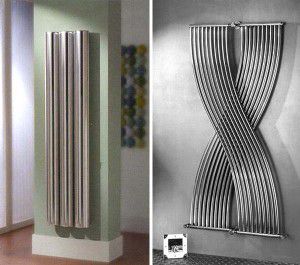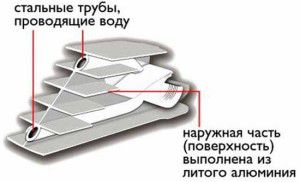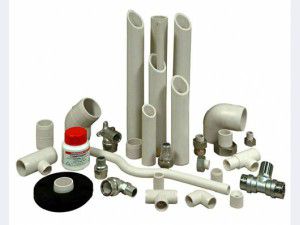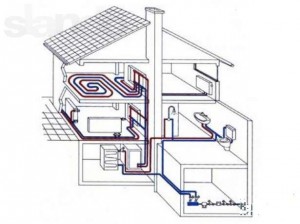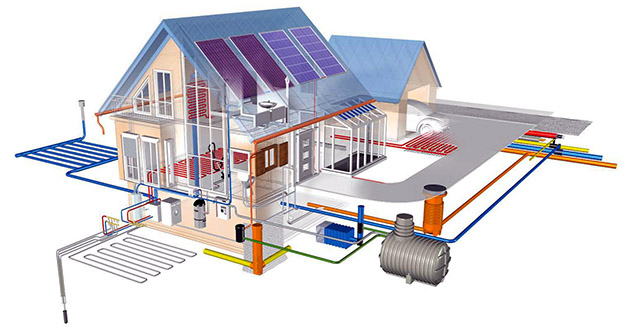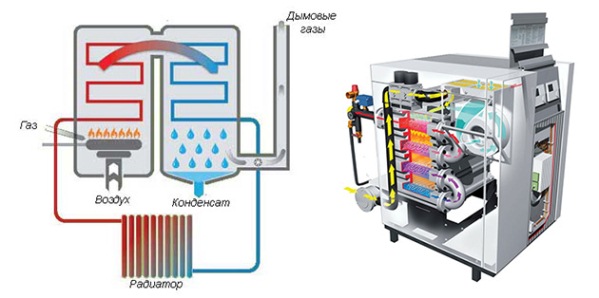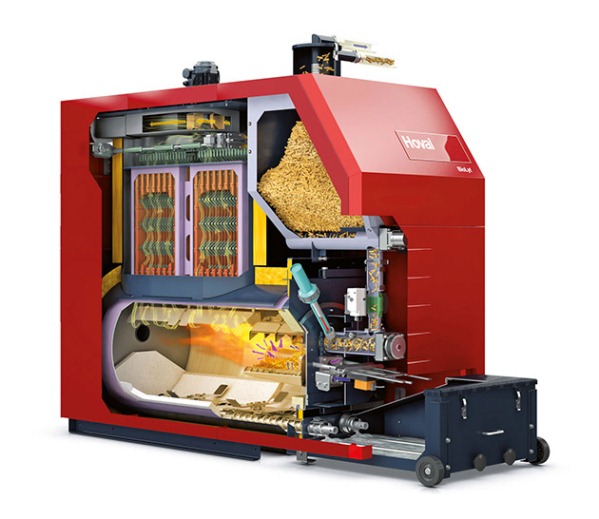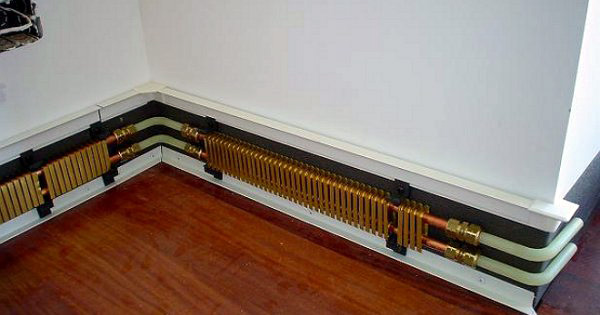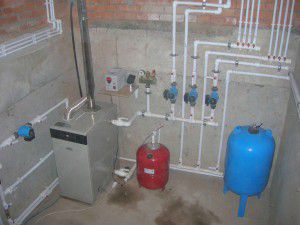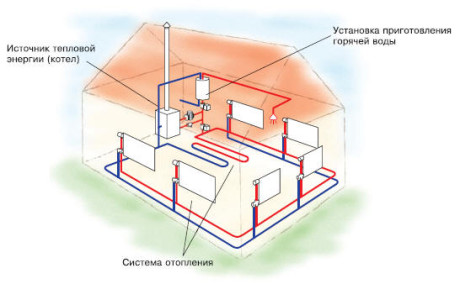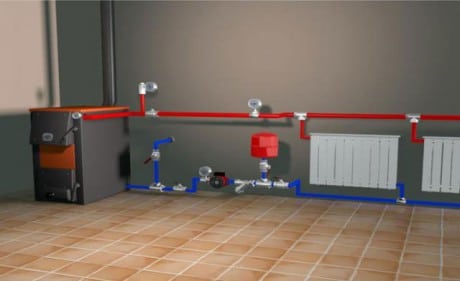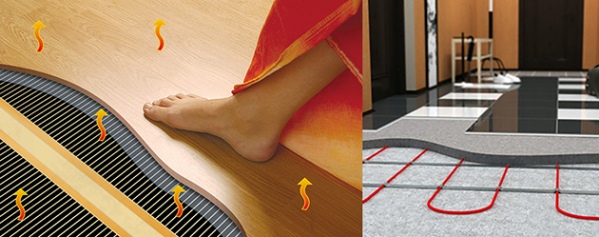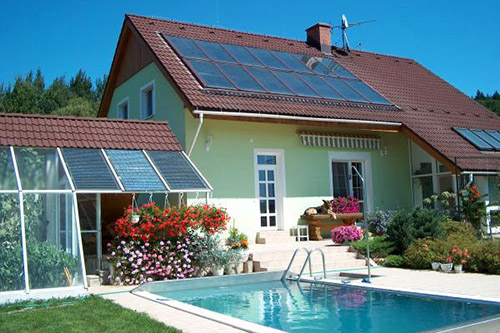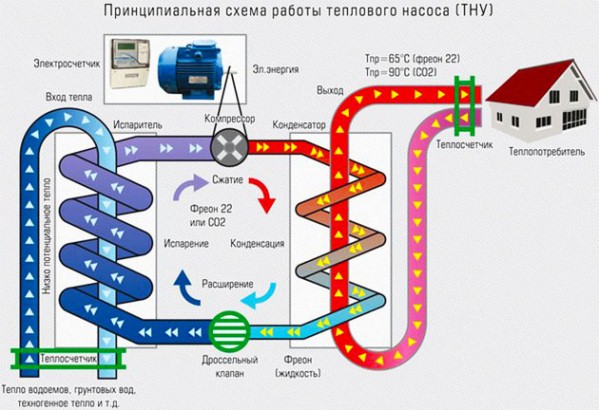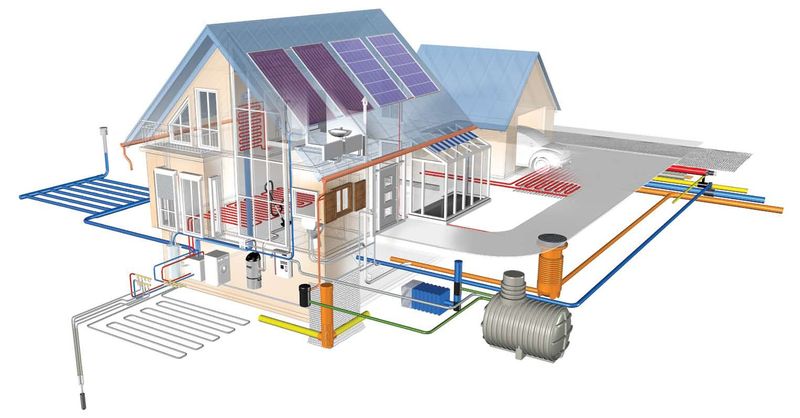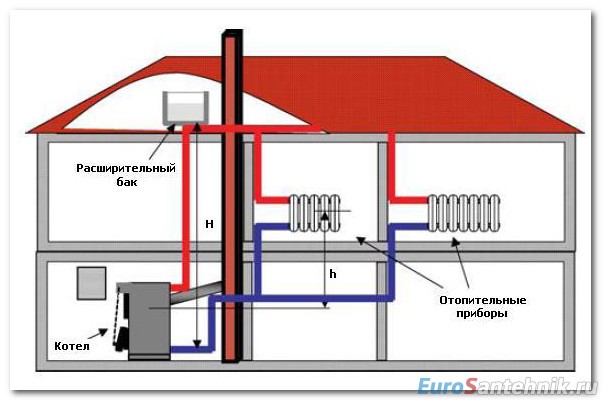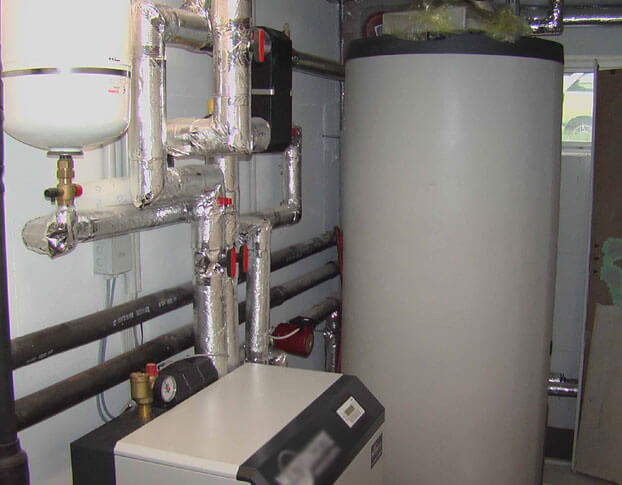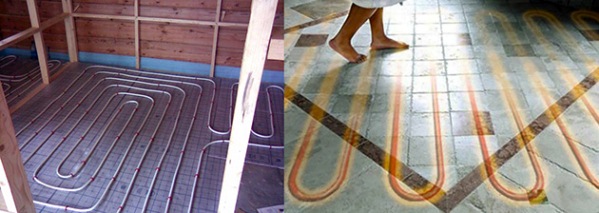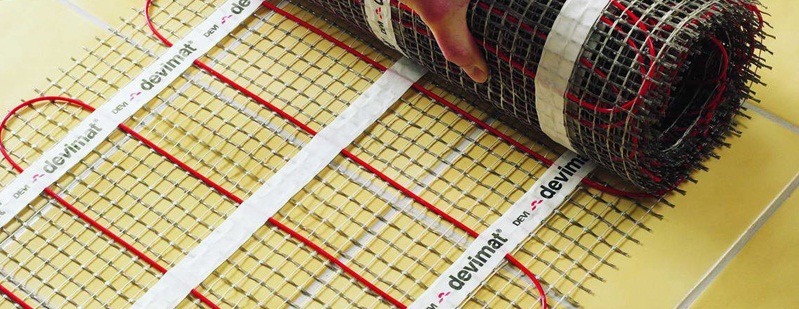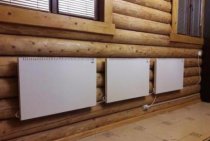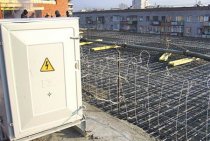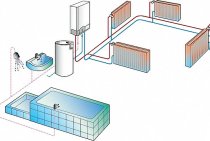Priorities of modern developments
In modern developments of heating systems, engineers focus on such factors:
- ease of installation work;
- compactness of the system;
- high efficiency (efficiency);
- low cost;
- ensuring good indicators of humidity indoors;
- low cost of 1 calorie of heat;
- use of harmless materials;
- high safety during equipment operation at maximum loads.
It is in these directions that all new developments that appear on the energy market are moving forward. Each system has its own advantages and disadvantages, therefore, a specific type of heating is selected based on the area of the house, floor, wall and ceiling insulation, heating seasonality, purpose of the room (residential, work, cottage, etc.).
Radiators and heating pipes
In addition to modern heating boilers, pipes and radiators are no less important components. They are necessary for the efficient transfer of heat energy to the air in the room. During the design of the system, it is necessary to solve two problems - to reduce heat losses during the transportation of the coolant through pipes and to improve the heat transfer of the batteries.
Any modern heating radiators must not only have good heat transfer performance, but also a design that is convenient for repair and maintenance. The same applies to pipelines. Their installation should not cause difficulties. Ideally, the installation can be carried out by the owner of the house himself without the use of expensive equipment.
Modern heating radiators
Design of heating radiators
To increase heat transfer, aluminum is increasingly being used as the main material for manufacturing batteries. It has good thermal conductivity, and casting or welding technology can be used to obtain the desired shape.
But keep in mind that aluminum is very sensitive to water. Modern cast-iron heating radiators do not have this disadvantage, although they have a lower energy intensity. To solve this problem, a new battery design has been developed, in which the water channels are made of steel or copper pipes.
These modern heating pipes practically do not corrode, having minimal dimensions and wall thickness. The latter is necessary for efficient thermal transfer of energy from hot water to aluminum. Modern heating radiators have several advantages, which are as follows:
- Long service life - up to 40 years. However, it depends on the working conditions and timely cleaning of the system;
- Choice of connection method – top, bottom or side;
- The package may include a Mayevsky crane and a thermostat.
In most cases, models of modern cast-iron heating radiators are made designer. They have classic forms, some of them are made in the floor version with artistic forging elements.
The efficiency of a heating radiator depends on the correct installation and connection method. This must be taken into account when installing the system.
Modern heating pipes
Polymer pipes for heating
The choice of modern heating pipes largely depends on the material of their manufacture. Currently, polymer lines made of polypropylene or cross-linked polyethylene are most often used. They have an additional reinforcing layer of aluminum foil or fiberglass.
However, they have one significant drawback - a relatively low temperature exposure threshold up to +90°C. This entails a large thermal expansion and, as a result, damage to the pipeline. Products from other materials can serve as an alternative to polymer pipes:
- Copper.From the point of view of functionality, copper pipelines meet all the requirements for a heating system. They are easy to install, practically do not change shape even at extremely high coolant temperatures. Even when water freezes, the walls of copper lines will expand without damage. The disadvantage is the high cost;
- Stainless steel. It does not rust, its inner surface has a minimum roughness coefficient. The disadvantages include cost and labor-intensive installation.
How to choose the optimal configuration of modern heating? To do this, it is necessary to use an integrated approach - to make the correct calculation of the system and, according to the data obtained, select the boiler, pipes and radiators with the appropriate performance characteristics.
The video shows an example of modern home heating using a warm floor system:
Types of heating systems
Heating of a residential building can be carried out according to the following schemes:
- with natural circulation
- with forced
Scheme with natural circulation of the coolant
The natural circulation of the coolant implies the non-volatility of the heating equipment. The coolant moves through pipes and radiators by gravity due to the pressure difference created by hot and cold water. This system is most often used for heating small houses up to 100 square meters. At the same time, an open-type expansion tank is installed, which is why the system itself is sometimes called "open".
Its disadvantage, despite the simplicity of the device and low cost, is that:
- it is only possible to heat a one-story house
- the length of the pipes should not exceed 30-40 meters
- active oxygen constantly enters the open expansion tank, which accelerates the corrosion of metal parts of heating equipment
- the tank, usually located in the attic of the house, is at risk of freezing in severe frosts, as a result of which the entire heating system may suffer
Important! Experts advise installing heating boilers for such a system with a cast-iron heat exchanger, since cast iron is less susceptible to corrosion processes. The heating system with forced circulation of the coolant, or closed, is more efficient if the area of \u200b\u200bthe house exceeds the conventional 100 square meters
In addition, it is able to heat a house of several floors.
The heating system with forced circulation of the coolant, or closed, is more efficient if the area of \u200b\u200bthe house exceeds the conventional 100 square meters. In addition, it is able to heat the house in several floors.
The principle of operation of this method is that a circulation pump crashes into the pipe coming out of the heating device. It helps the coolant move through pipes and radiators at the required speed, as a result of which all parts of the heating system are provided with hot water. But in systems with natural circulation, such an effect as cold return pipes or the formation of air locks can occur.
The disadvantage of this scheme is that it depends on the presence of a constant power supply. In addition, the installation of such a heating scheme will require significant financial costs from the homeowner.
Features of air heating systems
Scheme of air heating of the house.
The simplest and most obvious option for providing heat in the house is the organization of air heating of any room in a private house. It can be organized in the whole house completely. It is preferable to install these systems in industrial premises, which are designed to ensure that people stay in them for a fairly short time. This is due to the fact that during operation, heat guns operate on the basis of fans.The principle of operation of these heating systems involves the use of a heat exchanger, without which almost no modern heating system can do.
The warm air that is generated in these heat exchangers passes to the fans, which turn on from time to time and drive it around the room.
The inconvenience of using such a system in industrial and residential premises is that the fans operate almost constantly and are noisy.
However, these options become indispensable in private homes, in which there are rooms of impressive size. If you need to heat a hall or a terrace, then a heat gun will be the best solution: it will allow you to not only warm up in a relatively short time, but also provide the desired temperature for a very decent period of time.
The evolution of traditional systems and boilers
In Soviet times, when no one cared about the cost of energy, heating equipment and systems were quite primitive, although they were made very reliably and lasted for many years. Now the priorities have changed, modern energy-saving technologies have become relevant, which allow saving constantly rising energy carriers.
Thanks to this, traditional systems have become more perfect through the introduction of such solutions:
- increasing the efficiency of all boiler plants, excluding electric ones, since their efficiency is already very high (98-99%);
- the use of new materials and technologies for the manufacture of heating radiators;
- introduction of modern means of automation that controls the operation of systems depending on weather conditions and time of day, including remotely;
- the use of low-temperature heating networks - water heated floors with automatic heating control;
- implementation of heat extraction from exhaust air during air heating of buildings (recuperation).
A striking example of energy-saving gas equipment are condensing boilers, where the most modern heat exchangers are installed. The fact is that when methane is burned, water is formed, which immediately evaporates in the burner flame and thus takes away part of the heat generated. The heat exchanger of a condensing boiler is designed to force the vapors to condense and give this energy back. Due to this innovative solution, the efficiency of the heat generator reaches 96%.
The burners have also undergone changes, now they can independently dose the amount of fuel and air, as well as automatically change the intensity of combustion. This also applies to solid fuel boilers that burn wood pellets - pellets. Due to the purity of this type of solid fuel, full automation of the process and a developed heat exchange surface, a modern pellet boiler can operate with an efficiency of up to 85%.
An increase in the efficiency of conventional wood-burning boilers for heating private houses can only be achieved by taking heat from flue gases, the average of these units is 70-75%.
Modern heaters are made from the best heat-conducting materials - aluminum alloy and steel, although retro-style cast-iron batteries still have many fans. A real novelty in the field of heating is water skirting convectors made of copper plates and very efficiently transferring heat to the premises of a private house.
Component systems and their installation
Any new water heating installation technology always involves the use of innovative materials for the manufacture of its components. Thanks to the development of the polymer industry, more economical pipe models have appeared - polypropylene, cross-linked polyethylene and metal-plastic. They are easy to install and have a long service life.
Installation of polypropylene heating pipes
Heating using polypropylene pipes
Before the advent of modern technologies in heating, the installation of highways occupied the "lion's" share of funds and forces. Steel pipelines were connected by a welded method, and if it was impossible to use a welding machine - on threaded couplings. This did not always lead to the desired result.
The principle of heating installation technology from polypropylene pipes is to create joints using diffusion welding. The surface of the elements is heated to a fluid state, as a result of which they are soldered. This technique has a number of positive aspects:
- The ability to independently lay pipelines. To do this, you need to purchase a special soldering machine. The cost of the most affordable model is 400-700 rubles;
- Connection reliability. To do this, you only need to observe the heating time of the pipes;
- Simplified technology for mounting heating radiators.
However, polypropylene pipes have one important “minus” - the maximum possible water temperature should not exceed +90 ° C. Otherwise, their deformation and delamination of the reinforcing shell will occur.
To increase the heat output in new technologies for installing heating batteries, the installation of a reflective surface is provided. Most often used foil penofol.
Water heating
This is a closed heating system, it uses water or antifreeze as a coolant. Water is supplied through pipes from the heat source to the heating radiators. In centralized systems, the temperature is controlled at the heating point, and in individual systems - automatically (using thermostats) or manually (tap).
Types of water systems
Depending on the type of connection of heating devices, the systems are divided into:
- single-pipe,
- two-pipe,
- bifilar (two-furnace).
According to the method of wiring, they distinguish:
- top;
- bottom;
- vertical;
- horizontal heating system.
In single-pipe systems, the connection of heating devices is in series. To compensate for the loss of heat that occurs during the successive passage of water from one radiator to another, heaters with different heat transfer surfaces are used. For example, cast iron batteries with a large number of sections can be used. In two-pipe, a parallel connection scheme is used, which allows you to install the same radiators.
The hydraulic mode can be constant and variable. In bifilar systems, heating devices are connected in series, as in single-pipe systems, but the conditions for heat transfer of radiators are the same as in two-pipe systems. Convectors, steel or cast iron radiators are used as heating devices.
Advantages and disadvantages
Water heating is widespread due to the availability of coolant
Another advantage is the ability to equip the heating system with your own hands, which is important for our compatriots who are accustomed to relying only on their own strength. However, if the budget allows not to save, it is better to entrust the design and installation of heating to specialists.
This will save you from many problems in the future - leaks, breakthroughs, etc. Disadvantages - freezing of the system when turned off, a long time for warming up the premises. Special requirements apply to the coolant. Water in the systems must be free of impurities, with a minimum salt content.
To heat the coolant, a boiler of any type can be used: on solid, liquid fuel, gas or electricity. Most often, gas boilers are used, which involves connecting to the main. If this is not possible, then solid fuel boilers are usually installed. They are more economical than electric or liquid fuel designs.
The latest heating systems
An example of a fairly affordable and at the same time effective system, suitable for both a country house and an apartment, is an electric underfloor heating. Having incurred relatively small expenses for the installation of such heating, it is possible to provide a home with heat and not buy any boilers. The only drawback is the cost of electricity. But given that modern floor heating is quite economical, yes, if you have a multi-tariff meter, this option may be acceptable.
For reference. When installing an electric floor heating, 2 types of heaters are used: a thin polymer film with coated carbon elements or a heating cable.
In the southern regions with high solar activity, another modern heating system performs well. These are water solar collectors installed on the roof of buildings or other open places. In them, with minimal losses, water is heated directly from the sun, after which it is fed into the house. One problem - the collectors are absolutely useless at night, as well as in the northern regions.
Various solar systems that take heat from the earth, water and air and transfer it to a private house are installations in which the most modern heating technologies are implemented. Consuming only 3-5 kW of electricity, these units are able to "pump" from the outside 5-10 times more heat, hence the name - heat pumps. Further, with the help of this thermal energy, you can heat the coolant or air - at your discretion.
An example of an air heat pump is a conventional air conditioner, the principle of operation is the same for them. Only the solar system equally well heats a country house in winter and cools in summer.
It is a well-known fact that the more efficient an innovation in a heating system is, the more expensive it is, although it requires lower operating costs. Conversely, high-tech electric heating systems that are cheap to install make us pay later for the electricity we use. Heat pumps are so expensive that they are not available to most citizens of the post-Soviet space.
The second reason why homeowners gravitate towards traditional systems is the direct dependence of modern heating equipment on the availability of electricity. For residents of remote areas, this fact plays a big role, because they prefer to build brick ovens and heat the house with wood.
https://youtube.com/watch?v=eWUXWwH4UYk
Video. Energy efficient heating systems
https://youtube.com/watch?v=FYyh47j5vtU
With a total increase in the cost of heating residential and utility rooms, new technologies for providing heating in homes are increasingly of interest not only to professionals, but also to ordinary people. Standard gas, coal or electric systems are gradually becoming a thing of the past, rapidly becoming obsolete.
The choice of new heating systems is very large: there are complexes that are mounted directly during the construction of the house, there are those that can be installed during reconstruction, and some are used as an additional heating resource to the existing main structure, reducing the load on it.
Water heating
The most widely used water heating.
Advantages
- You can use one or more heat sources. According to physical parameters, water transfers thermal energy well. Heating devices, such as radiators, give off this heat, heating the air in the room.
- Fuel versatility. There are many ways to heat water. You can heat the premises with wood or coal, purchase a boiler for liquid fuel, supply natural gas. Finally, it is possible to heat water using boilers powered by electricity.
- Availability of materials and a wide range of products.The most suitable variant of heating devices is easily selected (cast iron batteries, modern bimetallic radiators, convectors and other devices). A large selection of pipes made of various materials (iron, copper, polypropylene, metal-plastic, etc.) will allow you to create a heating system according to any budget.
Water heating can be connected both from centralized networks, and be done autonomously. According to the design of the water heating system, there are:
a) One-way. Radiators are connected in series.
b) Two-pipe. Radiators in this case are powered in parallel between the supply and return lines.
c) Collector or otherwise beam. All heating devices are powered from a common distributor, called a collector.
Flaws
Disadvantages of water heating are also well known. This is a high susceptibility to corrosion and oxidation processes, uneven heating of radiators in some cases, rather large losses during heat transportation. In emergency situations, a coolant leak may occur.
Also, such a system requires compliance with the temperature regime. In sub-zero temperatures, it is necessary to completely drain the coolant from the networks in order to prevent their freezing.
Alternative heating options
With the constant increase in energy prices, alternative types of heating systems for a private house are steadily moving forward. Of course, they cannot fully replace the traditional methods of heating a private house, but they can significantly reduce costs.
In regions where the number of sunny days is quite large, solar batteries installed on the roofs of country and private houses can be increasingly observed. Sunlight is an inexhaustible source of energy, and allows you to use the converted electricity for many years.

Electricity, in turn, is used as power for heating heating elements. The only drawback of this type of energy production is the high cost of the elements, but over time, the costs pay off.
Solar energy can also be “conserved” and used with a solar collector. The principle of its operation is based on heating a radiator exposed to the sun, connected to a large volume tank. The sun's rays heat the water in the radiator, which in turn gives off heat to the tank.
This method allows you to heat water for use as a heat carrier in heating systems. The greatest effect is achieved when using vacuum collectors. Inside such radiators there are flasks with evacuated air, thus achieving the effect of a "thermos".
Wind turbines
It is clear that it will not work to use the power of the wind to heat the house directly. But on the other hand, by installing a "windmill" you can get free electricity, which is subsequently directed to various needs, including for powering heating systems. In regions where winds are especially frequent, this method of obtaining energy will be the most effective. Again, as in the case of solar panels, everything depends on the cost of batteries, converters and power generators.
Heat pump
This is a type of heating system that will help to significantly reduce the cost of heating a private house. The principle of its operation resembles the device of refrigerators or air conditioners. Such a device can pump out thermal energy from potential heat sources that do not differ in high temperature. They can be soil or water.

Such a system requires the supply of electrical energy, but at the output it can produce heat many times more than the resources spent on its operation. A significant disadvantage of the heat pump is its bulkiness and difficulty in installation.
In conclusion of this review, the following should be noted.The greatest efficiency in heating your own home is shown by the method in which the result is achieved at minimal cost, compared with other methods.
Therefore, it is impossible to speak with confidence about the advantages of one method of heating housing over another. In places where natural gas is widely used, it is foolish to install solid fuel boilers as the main source of heating.
First of all, in choosing the best way to heat your home, you need to consider expediency. To summarize, we can draw the following conclusion - in the vast majority of cases, only two sources of energy are conditionally used for the operation of heating devices:
a) Energy obtained by combustion of a variety of fuels, further heating the coolant;
b) Electrical energy used to heat thermal installations, air and/or heating devices.
But the methods and techniques for obtaining the result can be in the dozens. Therefore, most often, savings can be achieved by combining various methods of generating energy using various types of heating. All nuances and costs require careful calculations. After all, the owner will maintain his home at his own expense.
Fillings and eyeliners
Polypropylene pipes reinforced with aluminum or fiber are well suited for creating spills and connections. These products are valued for simple installation that does not require special equipment. In addition, polypropylene reinforced pipes are durable and strong, which is always a positive quality. Of course, ordinary polypropylene pipes can be used, but reinforced products have much better tear resistance, which in some situations can be a very good help.
In addition to the advantages, polypropylene pipes also have disadvantages, the main among which is a high coefficient of thermal expansion. To eliminate this problem, expansion joints are used, which are U-shaped or round bends. Reinforcement reduces expansion to a level comparable to steel products. The choice of material for reinforcement depends mainly on the wishes of the homeowner. Aluminum foil, according to popular belief, protects the coolant from contact with oxygen, since the walls of the pipeline allow some air to pass through, but this opinion may be too exaggerated. The use of fiberglass in this case will be more profitable, since it will not be necessary to clean the pipe from the remnants of melted foil during welding - and this directly affects the ease and speed of installation.
The choice of pipes of a suitable diameter is also an urgent issue, and here you have to start first of all from the type of heating system used. For example, for heating systems that use natural fluid circulation, DN32 pipes with an outer diameter of 40 mm are most often used. In structures equipped with a pump, pipes DU20 with an outer diameter of 25 mm can be used.
You can make connections to heating devices from the same pipes, except when collector wiring is used: in this case, each radiator has its own pair of pipes, usually 16 mm cross-linked polyethylene products. Practice shows that combining radiant wiring and underfloor heating in a room is a rather laborious task, and such a design will not receive the title of “the simplest heating of a private house”, but there are cases when the collector connection of heaters and water heated floors is still used.
About underfloor heating and air heating
The widely used underfloor heating systems are not all that new. But they proved to be very economical in practice, and here's why:
- the coolant in the underfloor heating circuits is heated to no more than 45 ° C;
- the room is heated by the entire surface of the floor;
- the system lends itself well to the management of modern automation tools;
- the heated screed retains heat for a long time after turning off the heating.
Note. In addition to the fact that the warm floor effectively uses heat, it provides its supply to the lower zone of the room, which is very comfortable for the people there.
Modern solutions in terms of air heating of buildings are not to lose the heat spent on heating the ventilation air. Extraction of heat from the exhaust air is carried out by special heat exchangers - recuperators. These are truly innovations in heating, as they are able to recover up to 80% of the spent energy and transfer it to the supply air, significantly saving energy.
Electricity
Separately, it is worth mentioning the electric form of heating. The very word "electricity" has firmly entered our everyday life. The area of electricity use in the world is approaching one hundred percent.
Therefore, as an option, you can use heating systems that are fully powered by electricity. In some cases, it may be advisable to install, for example, electric underfloor heating, heated towel rails in bathrooms, small radiators.
However, electricity is constantly growing in price, and this factor must be taken into account when installing electrical heating devices rationally.
It is also especially important to observe electrical safety measures, to install such equipment with the help of qualified specialists.
Heat source boiler selection
The question of choosing a heating boiler usually becomes a much bigger problem than the selection of pipes or heaters. There are a variety of models of boilers on the market, each of which is suitable for certain situations. What do you need to build on when sorting through the options for heating a private house?
For example, in the absence of a gas pipeline, gas boilers will have to be excluded. Of course, you can stretch the gas to your site, but the cost of this operation will be too high, and such costs can only be justified in very rare cases when the system pays off in the long term. Gas heating is the most profitable heating of a private house. It is gas that is the cheapest energy resource, and if the main is already connected, then the best source of heat will be a condensing boiler, combined with an additional circuit that supplies the house with hot water. It is quite simple to justify such a choice: firstly, it has a fairly high efficiency, which is 10-12% higher than the classical solutions.
Secondly, these devices require a low temperature in the return circuit of the pipeline, which in this case will be an advantage. The use of a storage water heater will make it possible to control the temperature of hot water much more accurately, and much less raw materials will be used for heating. Often, when calculating a gas heating system, only the heat obtained from the combustion of gas is taken into account, and if condensation is also taken into account, then the design efficiency is simply prohibitive.
The designs described here are just examples of heating a private house, and they depend on a wide variety of parameters. If it is not possible to connect to a gas main, you will have to use a solid fuel boiler equipped with a heat accumulator: in terms of operating costs, such a system occupies the second position, since firewood and coal are of low cost. In addition, self-procurement of raw materials will give great savings.
The heat accumulator will allow heating the system less often, which will allow the boiler to be used in the optimal mode.To achieve the highest efficiency, such systems must be fully heated, bringing the boiler to its design power: constant manipulation of the dampers will lead to incomplete combustion of the fuel, which will immediately affect the efficiency of the structure. The most profitable heating of a private house in the long run is a heat pump. These devices come in different configurations and require different conditions, but their use in the long run is very beneficial. For warm climates, air-to-water pumps or inverter air conditioners are well suited: such designs have extremely high efficiency: on average, one kilowatt of energy expended can give about 5 kW of energy received, which is a very good indicator (read: "Inverter home heating, what and how it works ").
The cost of air conditioners is low and quite comparable to the cost of a budget heating system. If there is a reservoir near the building or when groundwater is at a high level, the water-to-water scheme can be used, but the cost of such heating will be many times higher than the traditional solution.
The most expensive solution is the geothermal pump, which itself is expensive and requires labor-intensive installation. However, this design is practically independent of external conditions, and the service life of the pump can reach 30-50 years. Given the dynamics of rising energy prices, this type of heating a private house can be a justified solution.
To choose the most efficient heating for a private house, it is necessary to evaluate many factors. The main thing is to remember that the system should provide the premises with heat and create a cozy atmosphere. The proposed recommendations will help when choosing a heating system.
